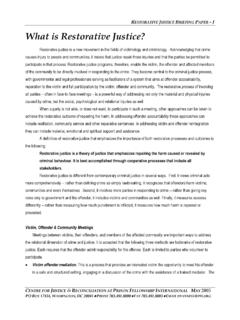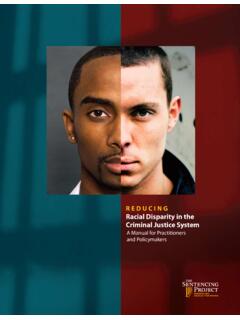Transcription of Offender Reentry: Correctional Statistics, Reintegration ...
1 Offender reentry : Correctional statistics , Reintegration into the community , and Recidivism Nathan James Analyst in Crime Policy January 12, 2015 Congressional Research Service 7-5700 RL34287 Offender reentry : Correctional statistics , Reintegration into the community Congressional Research Service Summary The number of people incarcerated in the United States grew steadily for nearly 30 years. That number has been slowly decreasing since 2008, but as of 2012 there were still over 2 million people incarcerated in prisons and jails across the country. The Bureau of justice statistics (BJS) reports that since 1990 an average of 590,400 inmates have been released annually from state and federal prisons and almost 5 million ex-offenders are under some form of community -based supervision.
2 Nearly all prisoners will return to their communities as some point. Offender reentry can include all the activities and programming conducted to prepare prisoners to return safely to the community and to live as law-abiding citizens. Some ex-offenders, however, eventually end up back in prison. The BJS s most recent study on recidivism showed that within five years of release nearly three-quarters of ex-offenders released in 2005 came back into contact with the criminal justice system, and more than half returned to prison after either being convicted for a new crime or for violating the conditions of their release. Compared with the average American, ex-offenders are less educated, less likely to be gainfully employed, and more likely to have a history of mental illness or substance abuse all of which have been shown to be risk factors for recidivism.
3 Three phases are associated with Offender reentry programs: programs that take place during incarceration, which aim to prepare offenders for their eventual release; programs that take place during offenders release period, which seek to connect ex-offenders with the various services they may require; and long-term programs that take place as ex-offenders permanently reintegrate into their communities, which attempt to provide offenders with support and supervision. There is a wide array of Offender reentry program designs, and these programs can differ significantly in range, scope, and methodology. Researchers in the Offender reentry field have suggested that the best programs begin during incarceration and extend throughout the release and Reintegration process.
4 Despite the relative lack of highly rigorous research on the effectiveness of some reentry programs, an emerging what works literature suggests that programs focusing on work training and placement, drug and mental health treatment, and housing assistance have proven to be effective. The federal government s involvement in Offender reentry programs typically occurs through grant funding, which is available through a wide array of federal programs at the Departments of justice , Labor, Education, and Health and Human Services. However, only a handful of grant programs in the federal government are designed explicitly for Offender reentry purposes. The Department of justice has started an interagency reentry Council to coordinate federal reentry efforts and advance effective reentry policies.
5 The Second Chance Act ( 110-199) was enacted on April 9, 2008. The act expanded the existing Offender reentry grant program at the Department of justice and created a wide array of targeted grant-funded pilot programs. Offender reentry : Correctional statistics , Reintegration into the community Congressional Research Service Contents Background .. 1 Correctional System statistics .. 1 Population in Correctional Facilities .. 2 Offenders Under community Supervision .. 3 Probation .. 4 Parole .. 4 Recidivism .. 5 Bureau of justice statistics 2005 Recidivism Study .. 6 Limitations of Recidivism statistics .. 10 Offender reentry : A Brief Literature Review .. 11 Offender reentry Defined .. 12 Program Effectiveness: The What Works Literature.
6 12 Employment .. 14 Substance Abuse Treatment .. 14 Education .. 14 Mental Health .. 15 Housing .. 15 Limitations of the What Works Literature .. 16 Conclusions .. 16 Federal Offender reentry Programs .. 17 Offender reentry Programs at the Department of justice (DOJ) .. 17 Offender reentry Programs at Other Federal Agencies .. 18 The Department of Labor (DOL) .. 19 The Department of Education (DOE) .. 19 The Department of Housing and Urban Development (HUD) .. 19 The Department of Health and Human Services (HHS) .. 20 Coordination Between Federal Agencies .. 20 Conclusion .. 21 Figures Figure 1. Number of Inmates Incarcerated in the United States, 2000-2013 .. 3 Figure 2. Number of Offenders Under community Supervision, 2000-2013.
7 5 Figure 3. Proportion of Released Prisoners Arrested for the First Time at the End of the Year and Cumulative Percentage of Released Prisoners Rearrested .. 7 Figure 4. Proportion of Released Prisoners Rearrested, by Offense Type .. 8 Figure 5. Proportion of Released Prisoners Rearrested, by Criminal History .. 9 Figure 6. Measured Recidivism Based on Different Definitions of Recidivism .. 10 Offender reentry : Correctional statistics , Reintegration into the community Congressional Research Service Tables Table B-1. Authorized and Appropriated Funding for the DOJ reentry Program, FY2001-FY2008 .. 32 Table B-2. Authorized and Appropriated Funding for the Second Chance Act Grant Programs Administered by the Department of justice , FY2009-FY2015.
8 32 Appendixes Appendix A. Section-by-Section Summary of the Second Chance Act .. 23 Appendix B. Appropriations for DOJ reentry Grant Programs .. 32 Contacts Author Contact 33 Offender reentry : Correctional statistics , Reintegration into the community Congressional Research Service 1 Background Over 95% of the prison population today will be released at some point in the Since 1990, an average of 590,400 inmates have been released annually from state and federal The Department of justice s (DOJ s) Bureau of justice statistics (BJS) has estimated that nearly three-quarters of all released prisoners will be rearrested within five years of their release and about 6 in 10 will be Many studies have indicated that reentry initiatives that combine work training and placement with counseling and housing assistance can reduce recidivism According to the BJS, the average per prisoner cost of incarceration in state prison in 2010 was approximately $28,000 per States collectively spent nearly $ billion on their Correctional systems in 2010, the most recent year for which data are Offender reentry includes all the activities and programming conducted to prepare ex-convicts to return safely to the community and to live as law-abiding citizens.
9 reentry programs are typically divided into three phases: programs that prepare offenders to reenter society while they are in prison, programs that connect ex-offenders with services immediately after they are released from prison, and programs that provide long-term support and supervision for ex-offenders as they settle into communities permanently. Offender reentry programs vary widely in range, scope, and methodology. The best-designed programs, according to the research in the field, are those that span all three Correctional System statistics To understand the issue of Offender reentry , one must first understand the ways in which ex-offenders are released into the community . It is also worthwhile to analyze the population of individuals serving sentences in Correctional facilities, because the number of offenders re-entering the community is necessarily related to the number and type of offenders serving prison sentences.
10 This section analyzes national data on the nation s Correctional system. 1 Department of justice , Office of justice Programs, Bureau of justice statistics , reentry Trends in the United States, ; hereinafter reentry Trends. 2 E. Ann Carson and Daniela Golinelli, Prisoners in 2012: Trends in Admissions and Releases 1991-2012, Department of justice , Office of justice Programs, Bureau of justice statistics , NCJ 243920, Washington, DC, December 2013, p. 3. 3 Matthew R. Durose, Alexia D. Cooper, and Howard N. Snyder, Recidivism of Prisoners Released in 30 States in 2005: Patterns from 2005 to 2010, NCJ 244205, April 2014, p. 1. 4 Wilkinson, Reginald A., Director of the Ohio Department of Rehabilitation and Correction, Offender reentry : A Storm Overdue, Paper Prepared for Third National Forum on Restorative justice , March 2002, on file with the author.














